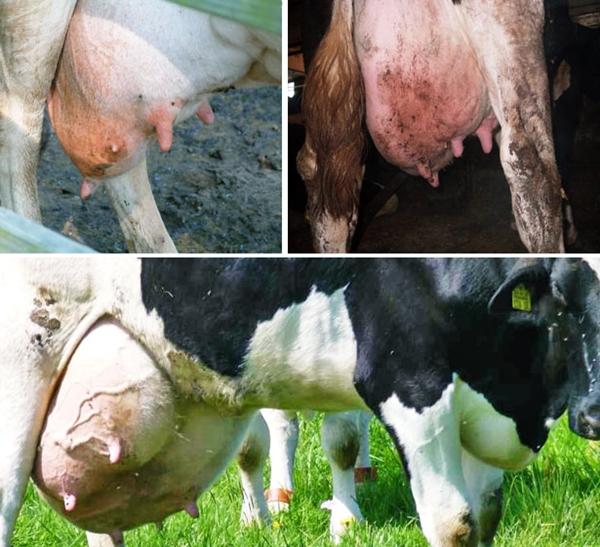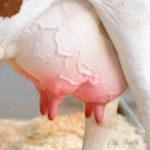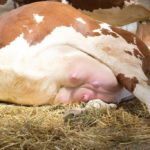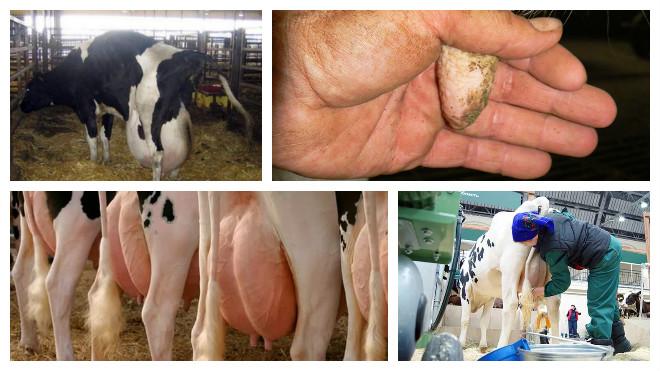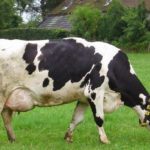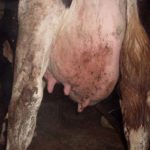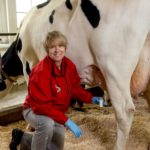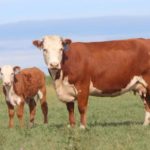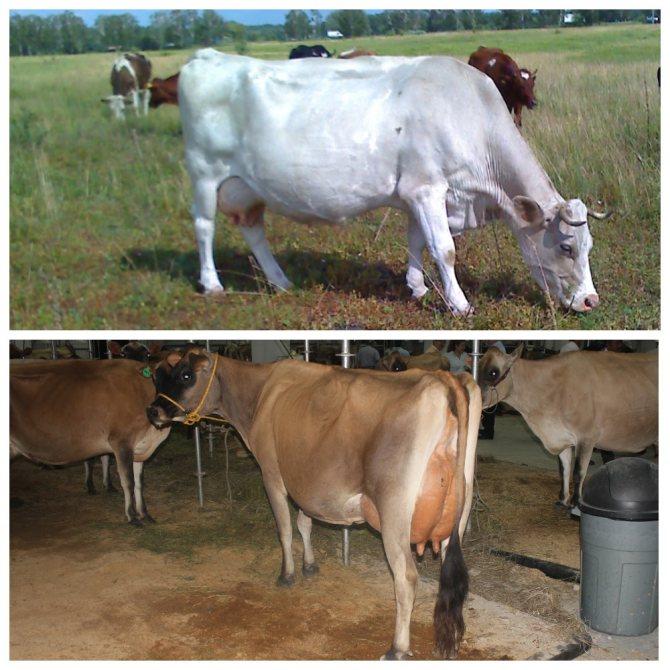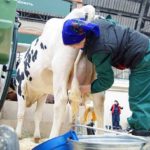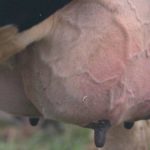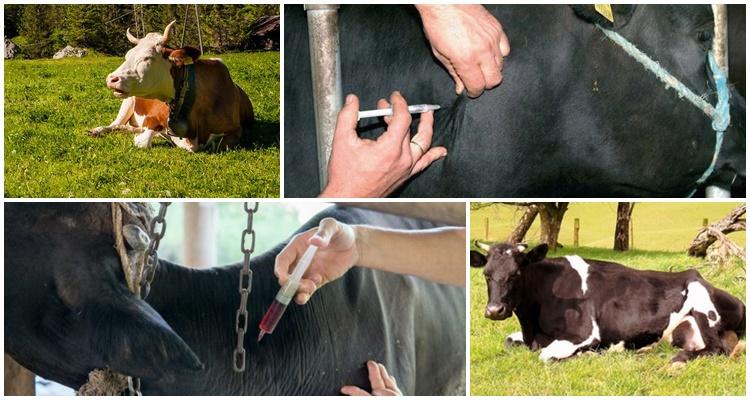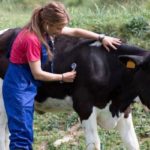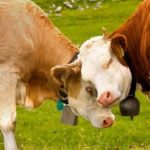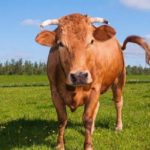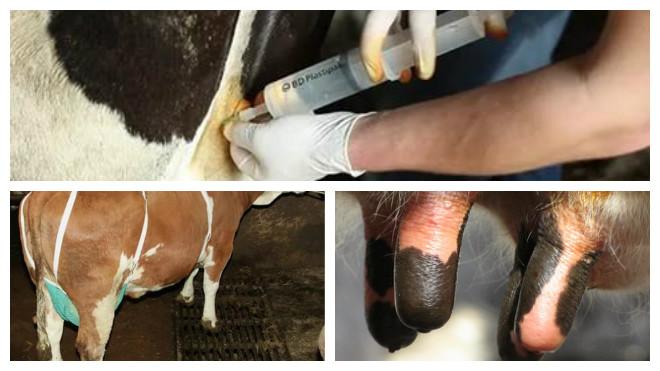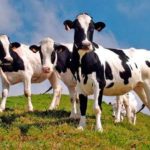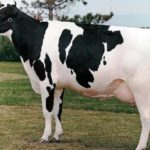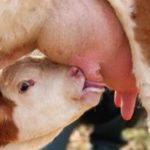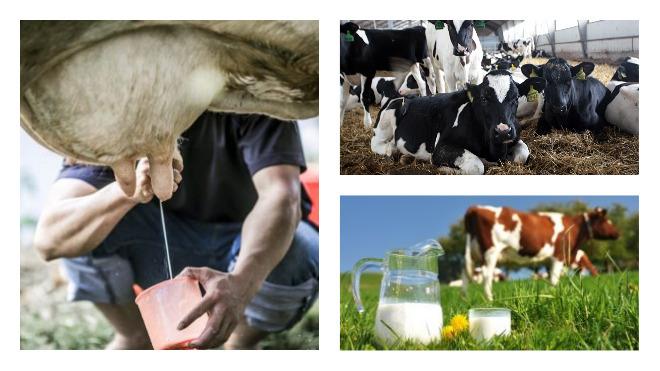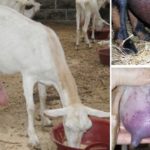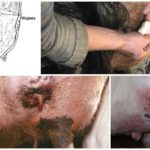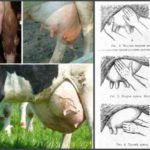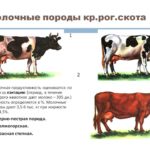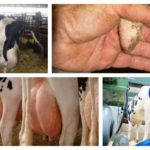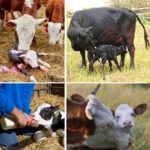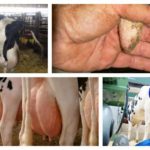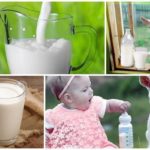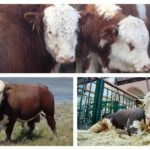The reason why cows are kept is to get milk regularly. A decrease in milk production, deterioration in the quality of the product, or a change in the general condition of the cow may indicate the development of mastitis. This is a serious disease that must be treated correctly and promptly. Cows undergoing an adaptation period after calving are especially susceptible to the disease.
- The main causes of mastitis in cows
- Bacteriological
- Mechanical
- Physiological
- Chemical
- Thermal
- Symptoms and types of disease
- Catarrhal
- Subclinical
- Chronic
- Serous (clinical), acute serous
- Fibrous
- Colimastitis
- Purulent
- Purulent-catarrhal
- Hemorrhagic
- Gangrenous
- Diagnostics
- Treatment of mastitis in cows
- Antibiotics
- Folk remedies
- Prevention
- Is it possible to drink milk from sick animals?
The main causes of mastitis in cows
Mastitis is an inflammation of the mammary gland in a cow. The udder increases in size and ulcers form on the surface of the udder. The cow experiences pain, some animals' body temperature rises, behavior changes, and their health deteriorates significantly. Treatable forms of mastitis affect one quarter of the udder. In this case, the lobe that is not covered with ulcers, is not enlarged or inflamed, produces normal milk.
Bacteriological
More than 85 percent of the causes of mastitis are based on the spread of pathogenic bacteria, fungi, and parasites. Factors that lead to the development of mastitis:
- poisoning with low-quality food;
- getting litter into feed, mixing feces and feed;
- violation of sanitary and hygienic standards when keeping animals;
- lack of care for the cow after calving.
Mechanical
Udder injuries occur when milking technique is violated. In addition, the group of mechanical causes includes the appearance of abrasions, scratches, horsefly bites and parasitic insects on the udder.
Physiological
Decreased immunity is one of the causes of illness in cows. Poor housing conditions after calving, which do not allow the cow to recover quickly, lead to the formation of physiological prerequisites for the development of mastitis.
Physiological reasons may include dietary errors.Lack of vitamins and minerals, monotonous food and minimal amounts of drinking lead to a decrease in immune mechanisms. The group of physiological causes includes disturbances during the milking process.
Incorrect grip of the nipple, lack of udder hygiene, and the use of utensils that touch the udder during milking lead to the development of discomfort that can provoke disease.
Chemical
Treating an animal for symptomatic disease may lead to the development of mastitis. This occurs due to incorrect selection of medications or drug overdose. The accumulation of various chemical elements in the body leads to a decrease in protective barriers. In the presence of a third-party provoking factor, mastitis develops in 2-3 days.
Thermal
Mastitis develops due to the constant presence of the animal in a room with a low temperature. The risk of developing the disease increases during drafts in hot weather.
Symptoms and types of disease
Pathology is classified according to its main characteristics. A clear separation of symptoms allows the use of targeted drugs for treatment.
Catarrhal
Cows are susceptible to catarrhal disease during the milking period. Signs:
- the appearance of nodes near the nipple on the udder by the fifth day of inflammation;
- a watery, dirty secretion is mixed with the milk;
- milk becomes low-fat;
- The flakes fall out with the milk.
Information! Catarrhal form forms on one of the udder lobes.
Subclinical
Breasts of the subclinical type are characterized by an asymptomatic course. Deterioration in milk quality is determined by biological clinical analysis.
At the initial stage there are no symptoms, but as the disease progresses, significant swelling of the udder occurs.Veins appear on the entire surface of the udder, and the body temperature of this part of the body rises.
Chronic
The chronic type of mastitis develops against the background of an untreated inflammatory process. It is difficult to diagnose in a timely manner due to the lack of severe symptoms. One sign may be the presence of a hot udder in the cow during milking.
Serous (clinical), acute serous
This type of mastitis develops after the first calving. It becomes a consequence of improper milking or injury to the udder.
Symptoms:
- flake sediment;
- swelling and redness of part of the udder;
- enlargement of the lymph nodes located above the udder.
Reference! Serous mastitis is characterized by the appearance of bluish milk.
Fibrous
The fibrous form often becomes a continuation of the catarrhal form. In the tissues of cattle representatives, during fibrotic inflammation, an increased amount of fibrin begins to be produced. This process leads to destruction of the tissue structure and subsequent necrosis. Main features:
- decreased milk supply;
- discharge of pus from the udder;
- increased body temperature;
- "hot udder" syndrome.
Colimastitis
A complex form that cannot be treated. Signs:
- cessation of lactation;
- a sharp increase in temperature (up to 42 degrees);
- weight loss, dehydration.
Purulent
The purulent form leads to complications. Symptoms:
- redness of the udder, the appearance of knots;
- discharge of pus;
- release and fall of flakes.
Purulent clots actively form if the cow has a cold in her udder.
Purulent-catarrhal
A complex form of purulent mastitis, which is expressed by the appearance of pus in the milk. During milking, pus clogs the milk ducts and interferes with the removal of milk.
Hemorrhagic
The hemorrhagic form develops on the basis of serous or catarrhal inflammation of the udder. Signs:
- the appearance of blood in milk;
- watery milk;
- sedimentation;
- swelling, increase in udder temperature.
Gangrenous
The shape designation indicates that a quarter or a third of the udder is to be removed. Necrosis of the udder develops rapidly, the surface loses sensitivity, and the veins increase in size.
Diagnostics
There are several options that can be used to determine the presence of the disease. In addition to external signs, when making a diagnosis, veterinarians rely on clinical studies.
| Diagnostic methods | Description | Peculiarities |
| Physico-chemical | Determination of milk acidity index | Possibility to identify the hidden period of disease development |
| Cytological | Samples for sediment testing | Determination of all forms of the disease |
| Microbiological | Smears and samples from different parts of the udder | Ability to detect the presence of pathogens |
Diagnosis of mastitis in cows is carried out constantly. This is due to the fact that hidden forms of the disease are difficult to determine by appearance. The optimal time for diagnostics is dry period. During dead wood, diagnostics are carried out twice:
- at an early stage of dead wood;
- 10-15 days before calving.
A healthy cow is characterized by the presence of an increased amount of secretion at an early stage. It has a gray-white tint. There are no flakes at all. The second analysis indicates a decrease in secretion to 3-5 milliliters. It acquires a yellowish-brown tint and is characterized by increased viscosity and ductility.
After calving, the risk of developing mastitis increases. When starting, it is recommended to gradually monitor the condition of the udder so as not to miss the first possible signs of disturbances.The start-up is the period characterized by the milking of the cow after calving. At this time, healthy milk remains thin, watery, but without impurities. In the second month of launch, after the milk has burned out, a golden-colored secretion is released from the udder, which looks like liquid honey. If this does not happen, then the cow is probably sick.
Reference! Colostrum is released from the nipples for the first 5 or 7 days.
Treatment of mastitis in cows
For each form, pathologists have developed special treatment regimens. They include the use of targeted drugs and procedures that alleviate the general condition.
Principles of complex therapy:
- the development of the disease cannot be ignored;
- The glands should not be completely emptied of secretions;
- at the initial stage, attempts should be made to avoid antibiotics;
- Feeds with increased juiciness should be removed from the diet;
- when using serious drug therapy, it is necessary to use cardiac and tonic drugs;
- the cow should be milked every 4 or 5 hours;
- ointments, lotions or compresses used must be at room temperature, comfortable for the animal;
- syringes and catheters must be disposable;
- If there are no formations on the udder, it is recommended to carry out a simple massage to remove the seals.
Antibiotics
Treatment with antibiotics based on bicillins begins when the disease is complicated by a deterioration in the general condition.
Drugs for combination treatment:
- "Maximax". An antimicrobial agent that is produced in a dispenser syringe.
- "Benstrap." A two-component medicine that suppresses the spread of gram-positive bacteria.
- "Penmicin". The drug is prescribed to eliminate pathogens, but it does not help with the development of fungus.
- "Doreen."An antimicrobial agent that can relieve the symptoms of mastitis in 2 days, provided that the dosage regimen is followed.
Compresses and lotions are made with local antibiotics. Ichthyol ointment is used as an antimicrobial and warming agent. It helps to dissolve lumps formed due to blocked ducts.
In addition to it, Vishnevsky ointment or heparin ointment is used. The drugs help improve blood flow, distribute congestion and improve tissue condition.
Folk remedies
Experienced farmers are able to cure mastitis in cows at home, using available means. Alternative, traditional methods can quickly and effectively improve the condition of the animal.
Effective methods:
- Applications with clay. Nettle decoction is mixed with white clay. The resulting mixture is applied to the udder, then washed with warm plantain decoction.
- Garlic tincture. Concentrated alcohol-garlic tincture is diluted with water and injected into the udder twice daily through the nipple canal.
- Vegetable compresses. Cabbage leaves or grated carrots are applied to the udder, tied, and left for 30 minutes.
- Rubbing with laundry soap. Rubbing the udder with laundry soap leads to the resorption of the formations. At the same time, soap produces an antimicrobial and anti-inflammatory effect.
- Ointment treatment. For preparation, take part of the lard and part of the dried calendula flowers. The flowers are ground until dust forms and mixed with lard. The resulting ointment is rubbed onto the nipples, then washed with warm water.
Information! During treatment, the cow is isolated from other animals.
Prevention
Preventive measures, according to farmers, help avoid the occurrence of mastitis. Curing inflammation is much more difficult than adhering to the rules when planning the keeping and care of cattle.
Basic preventive measures:
- Each milking begins with wiping or washing the udder. The entry of bacteria into milk leads to a deterioration in the quality of the product. In addition, bacteria can get inside the nipple and cause inflammation.
- The udder is washed using warm water. This helps to avoid the development of thermal factors that provoke inflammation. After washing, wipe the entire surface with a dry, warm cloth.
- Noticeable wounds, abrasions or scratches on the udder that the cow received while walking are treated with hydrogen peroxide or iodine to avoid the development of irritation.
- Once dry or cracked nipples are detected, regular treatment with moisturizers is carried out. To do this, use a nourishing baby cream.
The set of preventive measures includes the following points:
- daily walk;
- regular examination of the animal, timely therapeutic assistance;
- adding enzymes, vitamins, probiotics to the diet;
- compliance with hotel safety regulations;
- the presence of a cow and a calf together in the first days after calving;
- use of modern milking machines.
The group of preventive measures includes compliance with maintenance rules. Premises for cows should be clean and bright. The stalls are thoroughly cleaned daily. General cleaning is done weekly. Old drinking bowls or feeding devices require timely replacement. In winter, it is necessary to maintain optimal levels of temperature and humidity in the premises.
Vaccination is a way to maintain the health of a cow, which reduces the risk of developing mastitis. For cows, one of two vaccination schemes is used:
- 3:3:3. This is a method where the entire livestock is vaccinated.The vaccination is repeated after 3 weeks, then after 3 months.
- Classic scheme. The first vaccine is administered 45 days before the start of expected calving. The second vaccine is administered 35 days after the birth of the offspring. The cow is vaccinated for the third time 62 days after the second vaccination.
Startvac is a popular vaccine against mastitis that shows good results. The vaccine consists of inactivated strains and an adjuvant. Vaccination prevents up to 90 percent of cases of subclinical and clinical mastitis.
Is it possible to drink milk from sick animals?
The milk product during the development of inflammation is called “mastitis milk.” The use of this product is prohibited. From the very beginning of the disease, somatic cells develop in the milk. The increased number of cells makes milk harmful to human health.
Taking mastitis milk leads to the following consequences:
- diarrhea;
- nausea, vomiting;
- sore throat, other infections caused by streptococcus.
The presence of harmful microorganisms in milk can provoke a decrease in immune qualities and a deterioration in overall health.
Spoiled milk has a foreign, unpleasant odor. Sediments form at the bottom. When heated, milk curdles and the taste differs from the normal product. Homemade mastitis milk often contains impurities of pus or blood.
After the animal has recovered, several weeks must pass before the milk is suitable for consumption. During this time, the number of somatic cells is stabilized, as well as the chemical composition is normalized and the fat content is adjusted.

